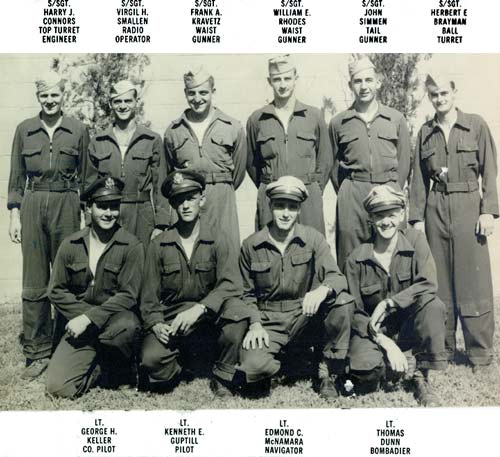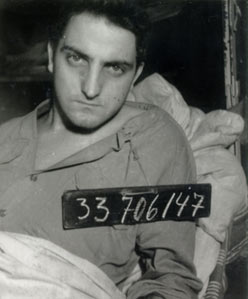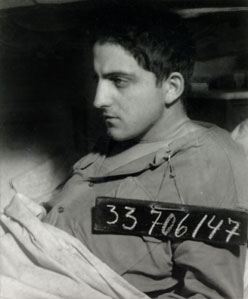Frank Kravetz
and
Crew 1944
 |
||
FORMER POW RECALLS WARTIME CHRISTMAS There was no Christmas joy for Frank A. Kravetz 50 years ago. On Dec. 25, 1944, Kravetz was recovering from burns and serious shrapnel wounds to his legs in a makeshift hospital for Allied prisoners of war in Obermassfeld, Germany. Kravetz, 71 of Chalfant, had been a POW since Nov. 2, 1944 when his B-17 bomber was shot down over Hanover, Germany. When he first reached the hospital set up in an old school, conditions were bearable. But by Christmas Day 1944, the hospital was jammed with new patients, most of them young American soldiers wounded and captured in the Battle of the Bulge, Hitler’s last-gasp effort to turn the tide of World War II in western Europe. The hospital in the days following the Battle of the Bulge was overwhelmed with patients. The newly wounded were laid on stretchers on the floor between the bunks. Supplies of food and medicine were running low. "In fact, you had guys literally dying left and right," Kravetz remembered. The new patients who survived brought devastating news. Prior to Hitler’s massive winter offensive, launched Dec. 16, 1944, it was widely believed that Allied forces would quickly bring Hitler’s war machine to its knees. But information brought to the hospital by the new patients dashed any hopes that Nazi Germany was ready to quit fighting. "The Germans were overrunning our troops," Kravetz said. Red Cross packages arrived in time for Christmas. Kravetz received a pipe and took tobacco from cigarettes to smoke in it. Pitchers of beer were provided, and the Germans arranged for a midnight Mass to be celebrated in Kravetz’s ward. Still, news of Germany’s surprise offensive, which caught Allied commanders off guard, over-shadowed the gifts. "Our morale at the hospital really went to a low ebb," Kravetz said. A retired purchasing agent for Westinghouse Electric Corp. in Churchill, Kravetz enlisted in the U.S. Army Air Corps in November 1943. After gunnery training, he was assigned to the 457th Bomb Group, 8th Air Force stationed in England. On Nov. 2, 1944, Kravetz and his crew took off from Glatton Air Force Base in England as part of a massive strike against German oil refineries. Ten crewmembers usually flew on the B-17, but the tail gunner of the bomber was sick. Kravetz agreed to man the guns in the tail. "Immediately after we dropped our bombs, we were attacked by German fighters," Kravetz recalled. "They happened to concentrate on our group. They came in directly at the tail level." Shrapnel from the fighter’s cannons tore apart Kravetz’ legs. Two of the B-17’s engines were knocked out. Other crewmembers ditched extra ammunition and equipment to lighten the plane. Kravetz, who was slipping in and out of consciousness, was dragged from the tail to the waist section of the aircraft. As the bomber limped along at an altitude of between 5,000 and 6,000 feet, enemy anti-aircraft gunners zeroed in on the crippled plane. "We were sitting ducks at that time. We were pretty low so our pilot dipped the wings (a signal that the crew wanted to surrender) and ordered us to bail out," Kravetz said. Kravetz’ fellow crewmembers treated his wounds with sulfur powder and compresses. After giving him morphine, they strapped Kravetz into a parachute harness, rolled the cloth chute into a ball, and placed it in their wounded buddy’s arms. Then they tossed Kravetz out of the plane. "I was conscious all the way coming down in the parachute. In fact I noticed it was 2:10 in the afternoon because I had my watch on" Kravetz said. He landed in a cabbage field where he managed to wriggle out of the parachute and give himself an injection of morphine. German civilians, set on retribution, spotted Kravetz. However, German soldiers interceded. "They fired some rifle shots in the air to scare off the civilians. They (the civilians) probably would have abused me and everything else" Kravetz said. "I just took my .45 out of my holster and I held it out in a non-threatening position," he remembered. "I wasn’t going to offer any resistance to them. What I needed was a lot of help because I wasn’t going to move anywhere for a long time. The solders took Kravetz’ wallet, personal photos, watch and jewelry. "Then they waited awhile. Someone went and found part of a fence and they used that as a stretcher to carry me to the road," he recalled. Kravetz was loaded onto a farm cart. As he was being wheeled down the road he saw another crewmember being escorted by soldiers. It was Bill Rhodes, a waist gunner who now lives in Madison, Wis. "Bill’s face was all battered, bloody and everything else," Kravetz recalled. "I asked him, what happened to you?" He said, "They beat…me." If you were wounded, I guess they had some sympathy toward you, which was my case," he added. Kravetz was taken to a barn. The soldiers left assigning the task of guarding him a group of Hitler Youth. After a few days, Kravetz was taken to a German hospital in Hanover. "At that point I thought surely they were going to amputate my left leg because it was turning black," Kravetz said, but a German surgeon saved the limb. Hanover’s rail yards and train station were the targets of air raids by British and American planes. During the raids, Kravetz remained in bed instead of being taken to an underground shelter. "Windows would shatter. Glass would fly. Beds would jump and everything else, it was just a horrible time to be alone. It would have been different if I had somebody with me to communicate with. I didn’t have anybody," Kravetz said. From Hanover, he was taken to the hospital staffed by the Allies in Obermassfeld. By the end of January 1945, Kravetz was scheduled to come home on a Swedish repatriation ship. But after the Battle of the Bulge "There were a lot more higher priority people so I went way down on the list," he said. He was sent next to a POW Camp called Stalag XIIID. After several weeks, he and other captives embarked on a 15-day forced marched to Stalag VIIA in Moosburg, Germany. Prisoners were given the option of walking or traveling by train to Moosburg. "I and a lot of the other fellows said, "Let’s walk, because you’re taking your life in your hands by going by train, everybody is strafing trains." They weren’t putting any markings on them (train cars) to signify that they were carrying POWs" Kravetz said. The march was difficult. "When you did stop to sleep, you slept in barns or under any kind of roof, whatever the Germans gave you. Or you just huddled together with someone else in the woods and just tried to sleep," he explained. American forces liberated the Moosburg Camp on April 29, 1945. By then, Kravetz – who at the time of his enlistment had to lose weight to come in under the 175-pound limit – weighed just 125 pounds. "I remember the flag going up over the barracks, the swastika coming down" Kravetz recalled. "(U.S. Gen. George) Patton came in and told us, "Everybody stay put. Don’t go roaming around the countryside because there are mines around. You fellas aren’t in any kind of shape to be traipsing around a lot." For the first time in months, Kravetz ate a slice of white bread. The liberated POWs were also treated to hot chocolate. "It made guys sick because it was too rich for them," Kravetz remembered. Frank Kravetz returned to Moosburg summer of 1999 to observe the 50th Anniversary of the liberation of the POW Camp. Photos during my internship!
Click Here to see letters to my loved ones. |

